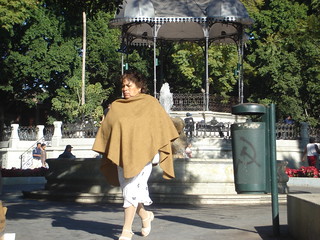
In a state dependent on tourism, striking schoolteachers assail Oaxaca's economic engine – again
OAXACA – Striking teachers pitched tents and held demonstrations in front of the El Importador restaurant over the past three weeks in the popular and leafy central square of this colonial city and state capital. According to shift manager Juan Vázquez, the protests drove down sales by 50 percent.
But even before the demonstrations began, he said, business had yet to fully rebound to levels achieved prior to the teachers strike in 2006 that descended into five months of violent street protests.
And so it was with a sigh of relief that he watched strikers packing up and heading home Saturday after a noisy rally, during which a band of young men wearing gas masks and toques used spray paint to scribble anti-government slogans on the walls, sidewalks and historic buildings that ring the Zócalo, a UNESCO World Heritage Site.
“This state depends heavily on tourism,” Vázquez said. “People here want to work.”
Ongoing disruptions by striking teachers and protesters from a left-wing group known as APPO have seriously damaged Oaxaca's tourism-dependent economy, according to many in the tourism sector, which the state government says directly and indirectly accounts for 80 percent of the region's economic activity. And the lack of visitors and plunge in sales comes mere weeks before the state's premier culture festival, the Guelaguetza, is scheduled to commence.
Some tourist-dependent workers expressed worries that the strikes and protests would continue keeping tourists away from the state famous for its archeological sights, diverse indigenous cultures and gastronomic delights like mole, mezcal and chocolate.
Like Vázquez, cabbie Daniel Moldonado, who ferries visitors from the airport to various parts of Oaxaca City, reported a 50-percent drop in business over the past three weeks.
While running a fare to the Zócalo on Saturday, he pointed at people waiting along the highway for buses that wouldn't arrive due to the “mega-march” that capped off the weeks-long sit-in.
“There's a way of protesting without interfering with bystanders,” Maldonado said.
Closer to the Zócalo, Ricardo Cruz, who teaches computer courses at a private college, said enrollment had dropped by two-thirds during the recent strike. He said the strike had divided Oaxaca residents – including his own family.
“Of every 10 people you meet, eight of them have teachers in their [immediate] family,” he said while eating a breakfast of tlayudas (a delicacy known as “Oaxacan pizzas”) at a café.
As if to illustrate his point, one elderly diner who identified himself as a teacher took exception to Cruz’s grumblings and stormed off.
Not all local entrepreneurs reported suffering from the strike, however. Local street vendors peddled everything from ice cream to pirated movies amidst the makeshift tent city that blanketed the city center.
And while local media reported that the teachers union and APPO had charged the vendors up to 150 pesos a day for the right to work in the encampment, those interviewed by The News denied the allegations. Some, in fact, said they were able to work more freely, since the municipal government was unable to carry out campaigns aimed at removing them.
“The teachers and APPO let us do our jobs,” said Ángel Ríos, a veteran vendor of ice cream bars.
“They're good people ... and good customers,” he added.
David Agren, The News


No comments:
Post a Comment